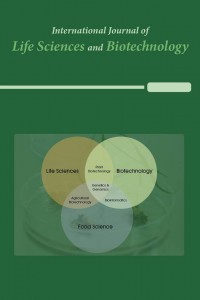Çeşitli evsel atıkların Aureobasidium pullulans tarafından melanin sentezinde kullanılması
evsel atık, melanin, Aureobasidium pullulans, fermantasyon
The use of various household wastes in the synthesis of melanin by Aureobasidium pullulans
Household waste, melanin, Aureobasidium pullulans, Fermentation,
___
- 1] Pralea, IE, et al., From extraction to advanced analytical methods: The challenges of melanin analysis. International Journal of Molecular Sciences, 2019; 20: p. 1–37.
- [2] Almeida-Paes, R, et al., Biosynthesis and functions of a melanoid pigment produced by species of the sporothrix complex in the presence of L-Tyrosine. Applied and environmental microbiology, 2012. 78: p. 8623–30.
- [3] Suwannarach, N, et al., Characterization of melanin and optimal conditions for pigment production by an endophytic fungus, Spissiomyces endophytica SDBR-CMU319. PLoS One, 2019. 14: p. 1–10.
- [4] Pitkaranta, M., and M. Richardson, Aureobasidium in Molecular Detection of Human Fungal Pathogens, D. Liu, Editor. 2011, Taylor and Francis. Florida. p. 37-49.
- [5] Chu, M, et al., Melanin nanoparticles derived from a homology of medicine and food for sentinel lymph node mapping and photothermal in vivo cancer therapy. Biomaterials, 2016. 91: p. 182–99.
- [6] Santhanalakshmi, K, et al., Fermentative production of melanin pigment from Streptomyces griseorubens DKR4 from agro waste products. International Journal of Applied Research, 2017. 3: p. 284–88.
- [7] Łopusiewicz, Ł., Natural sources of melanin. II International Conference Human Ecology, 2017. p. 127–77.
- [8] Tarangini, K, and S. Mishra, Production of melanin by soil microbial isolate on fruit waste extract: Two step optimization of key parameters. Biotechnology Reports, 2014, 4: p. 139–46.
- [9] Miller, G. L., Use of Dinitrosalicylic Acid Reagent for Determination of Reducing Sugar. Analytical Chemistry, 1959, 31(3): p. 426-428.
- [10] Dubois, M, et al., Colorimetric Method for Determination of Sugars and Related Substances. Analytical Chemistry, 1956, 28 (3): p. 350-356.
- [11] El-Gamal, M. S, et al., Isolation and characterization of melanized yeast form of Aureobasidium pullulans and physiological studies on the melanization process. Journal of Nuclear Science and Technology, 2017, 5: p. 57–72.
- [12] Mujdeci, G. N., Natural Melanin Synthesized by Aureobasidium pullulans Using Food Wastes and its Characterization. Applied Food Biotechnology, 2021, 8(4): p. 307–18.
- Yayın Aralığı: Yılda 3 Sayı
- Başlangıç: 2018
- Yayıncı: International Society of Academicians
Firdausi ALİYU, Aliyu ADAMU, Roswanira AB. WAHAB, Fahrul ZAMAN HUYOP
Plant Attractants and Rewards for Pollinators: Their Significant to Successful Crop Pollination
Nur Athirah ZARİMAN, Nurul Alia OMAR, A. NURUL HUDA
Cancer Suppression by Lymphocytes Activated by Cancer-Mediated Exosomes: an In Vitro Study
Aysegul YILMAZ, Irmak FERAH OKKAY, Ali TAGHİZADEHGHALEHJOUGHİ
Özlem BAKIR, Esabi Başaran KURBANOĞLU
Assessment of Food Safety During Covid-19 Pandemic
Cennet Pelin BOYACİ GUNDUZ, Mehmet Fatih CENGİZ
Hatice Aysun MERCİMEK TAKCI, Sema GENÇ, Ayşenur YALÇIN, Eda ÖZDEMİR
Sk Injamamul ISLAM, Moslema Jahan MOU, Saloa SANJİDA, Md. SAROWER-E-MAHFUJ, Md. Ashraful ALAM, Yeasmin ARA
Çeşitli evsel atıkların Aureobasidium pullulans tarafından melanin sentezinde kullanılması
